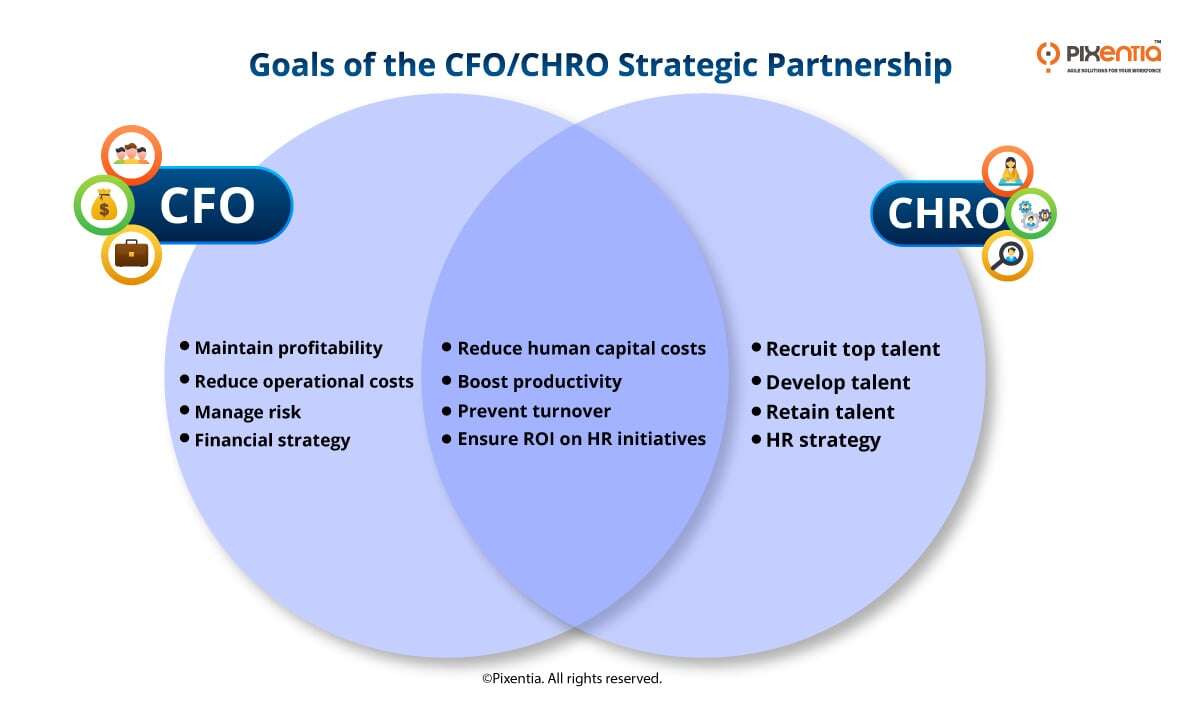
The Role of the CFO
If we reimagine the CFO as a superhero, the primary duty would be to protect and grow the bottom line… at all costs.
Pun aside, the key responsibilities of the role—financial management, planning, and reporting; record-keeping; forecasting; risk management and compliance—all boil down to reducing costs and maintaining profitability.
But the 21st century CFO is more than the guardian of the bottom line. The CFO has evolved into a cross-functional, strategic leader who uses finance and technology in a powerful combination to affect the organization and fuel growth.
CFOs and Finance departments have long been leaders in using data-driven analytics for strategy, so it is no stretch for them to use it for operational decision-making, such as in HR.
It’s a bird! It’s a plane! It’s the CFO with a bird's-eye view and complete visibility of all aspects of the business, including income and expenditure, performance, and operations. People analytics is one tool they use to influence the impact all business units have on profitability. It provides the strategic insight that removes the guesswork from operational and management issues allowing them to make smarter talent decisions, improve performance, and see beyond the limited scope of traditional practices.
Data insights allow the CFO to understand, predict, and optimize workforce behavior. From that position, they can monitor the company’s risk tolerance, identify opportunities for cost-cutting, optimize resources, and make predictions to close possible talent gaps.
The Importance of Collaboration between CFO and CHRO
An EY survey found a strong link between business performance and the level of collaboration between finance and HR.
At high-performing companies:
- CFOs and CHROs spend more time collaborating.
- There’s greater integration of finance and HR processes, and systems.
- The CFO had greater participation in strategic workforce planning.
- They use analytics to understand their workforce better.
What keeps the CFO up at night? Probably the single largest business cost—human capital expenditure.
With the workforce on average taking up 70% of operation expenses, HR data and people analytics are critical to the CFO for cost control reasons. Beyond the obvious labor costs like wages and benefits, other underlying costs like cost-per-hire and turnover costs can also take up a large chunk of the total cost of the workforce (TCOW).
The CFO and CHRO have to work together to keep these costs in check, optimize performance and ensure ROI on human capital investment.
By looking at financial and human data simultaneously the CFO can understand how changes in HR KPIs affect revenue. Analytics dashboards and visualizations will clue them into HR cost drivers.
The dynamic duo of CFO and CHRO is strategic partners who share mutual goals. It’s clear that the success of the business hinges on their having a close, collaborative relationship.

How CFOs Use People Analytics and Talent Data to Reduce Labor Costs
All three stages of the employee lifecycle incur costs: recruitment, development, and retention. The CFO has to work with HR to analyze and control those costs and maximize productivity and efficiency. In each stage, the CFO can use talent data to further their financial goals.
Here are some common high-cost areas of HR that the CFO keeps a handle on.
Recruitment
An inefficient hiring process is frustrating, time-consuming, and wastes company finances.
With average cost-per-hire figures increasing annually ($4700 in 2022), the CFO needs to swoop in. This metric, plus others like interviews-per-hire and time-to-hire, will affect the bottom line. Reducing recruitment costs is a priority. For example, people analytics can help determine the best locations to source talent since staffing costs will vary based on geography as salaries, benefit costs, and labor laws change.
Because of its predictive ability, people analytics illuminates the blind spots that would normally occur in decision-making.
Consider this scenario: a company sees profit declining and considers a hiring freeze as a solution. However, data analysis shows that the outcome of that decision would mean a shortfall in production, and the additional cost of overtime or contingent staffing would be more than the savings from the hiring freeze.
Unfilled roles affect efficiency and productivity, morale, overtime costs, and potentially, revenue. If you’re taking too long to fill roles because of sluggish recruitment, the CFO will need to know and work with HR to reduce spend in this area.
Drilling down in the analytics may reveal irregularities affecting the process. For example, if you’re struggling to fill vacancies quickly, analyzing the data might reveal a long, unwieldy shortlist. HR will need to work on tightening up the profile of the ideal candidate and/or improving the talent pool.
Strategic Workforce Planning
Gone are the days when the CFO’s approach to human capital was completely budget-driven. Today, the workforce strategy is driving the financial strategy instead of the other way around. First, you need to understand what the business needs talent- and skill-wise, then take that to finance.
Human capital cost management calls for a better understanding of the relationship between cost and performance, and the drivers of employee performance and engagement.
The CFO must analyze workforce trends along with economic and industry trends, and use them to model labor supply and demand scenarios.
Productivity and Performance
Another area of the business where people and profit intersect is productivity. Changes in productivity will obviously affect the bottom line so this is the CFOs business.
CFOs will want to use talent data to predict productivity and boost it by:
- Identifying and addressing lags in performance
- Identifying skills gaps that will affect performance
- Maximizing performance by working with HR to ensure the alignment of compensation packages, benefits, and rewards with business performance.
- Projecting the ROI of HR initiatives: for example, comparing productivity data with health and absentee data and health plan participation to see how employee wellbeing affects the business.
- Data analytics will help the CFO evaluate workforce productivity throughout the business to improve efficiency in production or time on tasks. Productivity metrics might uncover a need for automation, for example, to save time and money.
Turnover
Another potential runaway cost the CFO needs to monitor is turnover.
With the average turnover cost for one employee estimated at 1.5 to 2 times their salary, total annual turnover costs can be astronomical. The domino effect of both hard and soft costs can have a disastrous effect on profitability.
People analytics can help improve retention strategies throughout the employee lifecycle. It begins by using the insights gained from recruitment metrics to hire the right people for the right roles.
Once hired, effective onboarding helps to keep the new hire turnover rate in check. The next hurdle in keeping your talent is developing and engaging them. Talent development is a strategic investment that can keep attrition low among your top talent.
Keeping talent can be tricky since people leave for all kinds of reasons. People analytics takes some of the complexity out of it by allowing you to spot industry and market trends that affect risks within the workforce. Examples of this at work include Credit Suisse using diagnostic analytics to reduce attrition among female employees, and IBM using predictive analytics to measure flight risks.
The business case for CFO leveraging people analytics to achieve financial goals is undeniable. Studies have linked it with strong business performance and higher profit margins. Regardless of the size of your business, the bottom line is you stand to benefit from looking at financial and workforce data simultaneously.
Are you looking to optimize your people analytics practice to achieve better results? -1.jpg?width=1200&name=cta%20(2)-1.jpg)
Phenom eCloud is a comprehensive technology solutions provider committed to empowering businesses to overcome challenges, enhance their workforce capabilities, and achieve superior outcomes.




Leave a Comment